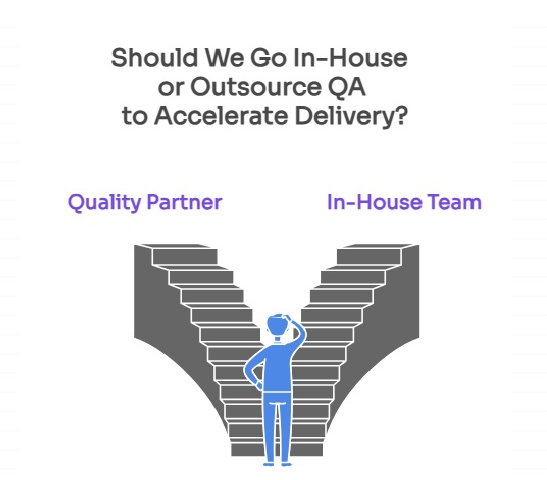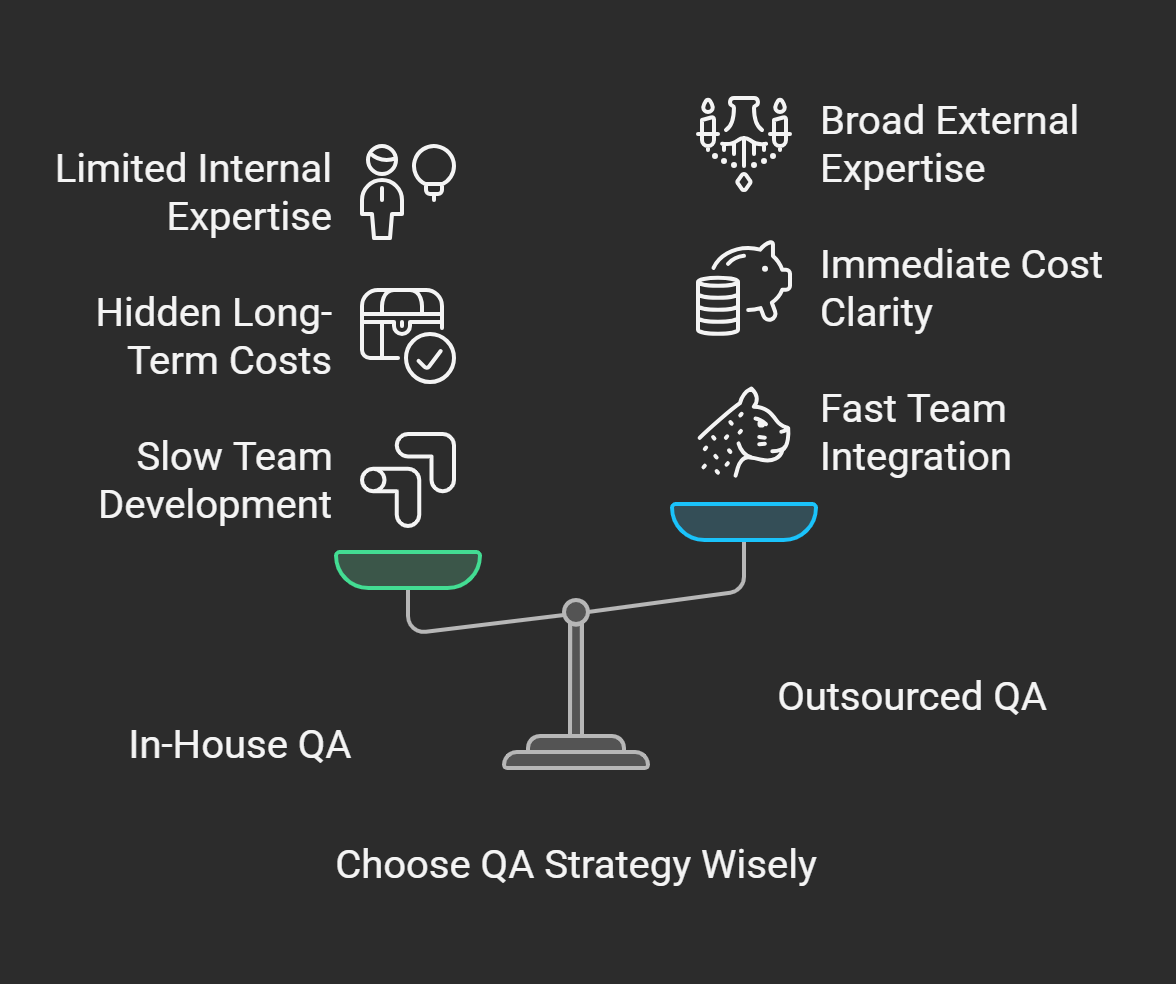Explore the pros and cons of QA outsourcing vs building an internal team. Discover insights that can help you improve speed, scalability, and long-term impact.


When companies seek to boost their testing strategy—especially with Generative AI and test automation—one key question arises: should we build an internal team or outsource and partner with a specialized firm?
While hiring full-time testers may appear more cost-effective at first, the reality is more complex, as the real costs (and risks) are often hidden. Beyond the initial cost, there’s the challenge of building expertise, keeping the team updated, and achieving quick impact.
In this article, we invite you to explore both paths, highlighting the value of expertise, scalability, and long-term ROI. Our goal? Helping you to make the smartest move, according to your goals, and context.
Looking for QA Outsourcing? Our Clutch Reviews speak for themselves! Contact us and let’s get started!
The Big Decision: In-House or QA Outsourcing?


Choosing how to scale your testing capabilities means weighing more than just costs. So before deciding on one path over the other, it’s essential to understand what each truly means in practice.
Going in-house isn’t just about hiring testers—it’s about building and sustaining a structure. In this article, we tell you everything about how we make it possible at Abstracta.
On the other hand, partnering with external experts isn’t about outsourcing tasks, but about integrating strategy, experience, and acceleration.
Why Building an Internal Team May Seem Appealing
At first glance, assembling your own QA team feels safer, like a long-term investment and a more stable path. You might think, “If we build it ourselves, we’ll own it fully.” That emotional comfort shouldn’t be underestimated, especially for organizations navigating constant change. Plus, if you’re hiring in regions with lower costs, it can look financially attractive too.
But this sense of stability can be misleading when speed and adaptability are urgent.
Building from zero—hiring, training, and maintaining engaged skilled professionals—is rarely quick or simple. It demands time, dedicated leadership, and a clear vision. You need to design roles, define career paths, set up processes, and create an environment where people can grow and stay engaged. And all of this must happen while the rest of your team is busy shipping products, resolving bugs, and meeting delivery deadlines.
So yes, it may look cost-effective and stable on paper. But in practice, building a high-performing QA team is a full-time initiative, one that competes with other pressing priorities. When quality needs to move fast and evolve constantly, this approach can quickly become a bottleneck rather than a boost.
What Expert Partners Bring to the Table from Day One
Choosing the right QA partner enables you to move faster, with confidence. You gain access to ready-to-go expertise, structured processes, and a culture of continuous learning—without carrying the operational load. Outsourcing QA also allows companies to maintain focus on their core business while still benefiting from expert-driven software testing strategies.
You don’t have to spend weeks (or months) recruiting. You skip legal and payroll challenges when working across countries. And most importantly, you don’t just get one expert—you get a team backed by collective experience, cross-industry knowledge, and proven frameworks.
Here’s what expert partners can unlock for you from day one:
- Accelerated onboarding: They’re ready to jump in, with context-aware tools and workflows.
- Breadth of expertise: You gain access to years of experience and specialists in AI, performance, security, automation, and beyond.
- External perspective: They spot blind spots your internal team may miss due to proximity.
- Cultural fit: The right partner aligns with your values, language, and working style.
- Scalability: They grow (or reduce) with your needs—no overhiring required.
When you hire one person, you get one person’s experience. When you hire a partner, you access experts’ knowledge, intelligence, company systems, and the capacity to adapt to evolving challenges.
The Illusion of Savings: Why Costs Aren’t What They Seem


What looks “cheaper” at first may cost more in the long run—especially when you consider time, risk, and opportunity.
Salaries are just one line in your budget. But building an in-house team brings a series of unseen and recurring costs that directly impact speed, quality, and sustainability. These challenges often lead organizations to consider outsourcing software testing services as a way to reduce operational burden while maintaining high standards in software quality.
Let’s take a closer look:
The Hidden Costs of an In-House QA Team
Recruitment
The process of sourcing, interviewing, and hiring skilled QA professionals demands significant time and financial resources. Delays in filling these positions can hinder project timelines and increase workloads for existing staff.
Onboarding
Integrating new team members involves setting up access, introducing company-specific processes, and providing the necessary context for projects. This period can span several weeks, during which productivity may be lower as new hires acclimate.
Upskilling
The tech landscape is continually evolving, necessitating ongoing investment in training and certifications to keep your team adept with the latest tools and methodologies.
Retention
Keeping skilled professionals engaged and preventing churn is a long game—and expensive when it fails. It requires strategic efforts and resources. High attrition rates not only incur additional recruitment costs but also risk the loss of valuable institutional knowledge.
Turnover
When someone leaves, knowledge and expertise leave too, potentially causing project delays and disrupting momentum. The subsequent recruitment and training of replacements further amplify costs.
Tooling & infrastructure
Licenses, test environments, hardware—it all adds up. Equipping your team involves a substantial investment. These expenses accumulate over time and are essential for effective testing operations.
Maturity
Another important factor to consider is the maturity and structure of your QA process. Whether you’re dealing with manual testing, automated testing, or more specialized needs like security testing, external partners often come with established methodologies that accelerate the testing process and improve reliability across releases.
Management Time
On top of that, management time becomes a major hidden cost. Alignment meetings, mentorship, reviews, and conflict resolution can divert attention from strategic priorities.
Ramp-Up vs. Instant Acceleration
Need to scale up or down? External teams adapt faster. You don’t need to overhire just to prepare for peak.
Internal teams need time to reach velocity. You may spend months training before they contribute at the desired level. That’s not always compatible with tight deadlines or urgent releases.
External partners, by contrast, are built for speed. They arrive with context-aware teams, onboarding plans, and agile routines that enable delivery from week one.
Don’t miss our article “Cost vs. Value: Analyzing the ROI of Outsourcing Application Testing Services“.
QA Outsourcing: Scaling Without the Growing Pains


If your roadmap includes fluctuations in demand, an internal team can become either overloaded or underutilized. Scaling a fixed team is slow, expensive, and often inefficient.
Partnering with an external company gives you agility at scale. Whether you’re entering a high-demand phase or pausing testing efforts, you can adjust the team size quickly—without compromising continuity or quality. Many companies find this flexibility invaluable when dealing with varying software development process cycles or when expanding software testing services to cover multiple platforms and environments.
The best partners work like an extension of your team: they’re here when you need them—and they step back when you don’t. No layoffs, no restructures. Just flexible support.
The right partner scales with you—and disappears when you don’t need them.
Finding the Right Fit for Your Testing Strategy


Whether you’re scaling up, optimizing performance, or seeking long-term innovation, having the right testing partner makes all the difference. For many companies, outsourcing QA brings the flexibility and expertise needed to meet evolving demands—without the overhead of building everything internally.
From embedded QA engineers to full-scale QA services, the right collaboration model can empower your team to move faster, reduce risk, and increase confidence across every release. At the same time, specialized testing services bring structured processes, cross-industry knowledge, and continuous improvement into your software lifecycle.
Discovering the ideal partner within this vast landscape requires careful consideration. Take a look at our “The Complete Guide to Software Testing Outsourcing” before making your decision.
Testing Without Strategy Is Just Expensive Noise


A common pitfall in fast-scaling teams is prioritizing tools or headcount over clarity. But without a defined strategy, even the best test automation can become a liability.
A Tool Without a Plan Is a Liability
Buying automation tools doesn’t mean your testing is strategic. Without goals, governance, and alignment, automation may only create false confidence. You might be running thousands of tests—and missing the ones that matter most.
What drives results isn’t the tool itself—it’s the strategy behind it, the team executing it, and the insights it enables.
Staying Ahead Is a Full-Time Job
Internal teams rarely have time for deep R&D. Internal teams often lack the bandwidth to explore new tools, adopt new practices, or experiment with innovative techniques. Their focus is on the day-to-day—and without dedicated time for R&D, they fall behind.
External partners, on the other hand, live and breathe what’s next. Why? The answer is simple: Their growth depends on staying ahead.
From performance testing under load to niche needs like API testing outsourcing, these partners have the depth of experience and access to tools that are often out of reach for in-house teams. This makes them a strategic asset when it comes to elevating your entire quality assurance approach.
At Abstracta, for instance, we invest deeply in research and community, constantly evolving our practice to meet the needs of future-ready teams. We don’t just follow innovation—we lead it
Risk is Not a Buzzword—It’s Your Bottom Line
Did you know that one overlooked defect can lead to costs that far exceed the monthly fee of a specialized partner?
Testing isn’t just about finding bugs—it’s also about protecting your reputation. Fragile test suites, gaps in coverage, and unnoticed failures can delay releases or affect users in production.
Risk is real—and minimizing it requires expertise.
Measuring Impact: Beyond Hours and Headcount


In QA, what matters isn’t how many people are involved—it’s how fast you can learn, adapt, and release with confidence.
Teams Built for Delivery vs. Teams Built for Learning
Your internal team will grow—but how fast, and at what cost?
In-house teams tend to balance execution with growth. But they can get stuck in delivery mode, without room for reflection or improvement. Partners, by contrast, are often structured to continuously learn, optimize, and share insights—because that’s their job.
Fast Feedback = Faster Releases = Competitive Edge
Partner-led teams enable acceleration without chaos.
One of the biggest advantages of working with experienced QA partners is the feedback loop. They optimize pipelines to deliver insights quickly, reduce cycle time, and help you release faster—without sacrificing stability.
Sustainability Is Not Optional
Burnout, turnover, and stagnation are common pitfalls of going in-house too early.
Testing teams that scale too fast—without mentorship or rhythm—are prone to burnout, turnover, and stagnation. A sustainable team is one that balances learning, delivery, and well-being.
A good partner supports you without exhausting you. That’s a long-term advantage.
Focus Matters: Where Should Your Energy Go?


Every hour spent managing infrastructure or team dynamics is an hour not spent improving your product. Choosing the right testing model is also about choosing where to focus your leadership energy.
Managing Teams vs. Managing Results
Internal teams need consistent oversight: career growth, performance evaluations, conflict resolution, and roadmap alignment. That’s real effort—especially if your product is scaling fast.
With the right partner, you can focus on outcomes instead of operations. They bring visibility, clarity, and results—so you stay focused on your users.
When a Quality Partner Unlocks Transformation
Strategic partners do more than test. They bring tested patterns, coverage models, and frameworks that speed up experimentation. They identify risks earlier. They remove friction.
They give you a fresh perspective and confidence to move faster with less guesswork.
When In-House Makes Sense—and How to Avoid the Traps
Building your own team can be powerful—if done intentionally. This means:
- Having a strong hiring strategy
- Investing in dedicated onboarding and coaching
- Providing space for continuous learning
- Creating clarity in goals and metrics
- Building leadership and mentorship inside the team
Without these, even a talented team may stagnate.
Conclusion


It’s not about one being better than the other. It’s about choosing the right model for your context, timeline, goals, and what kind of risk you’re really willing to take. The truth is simple: expertise accelerates impact. The earlier you access it, the more resilient your strategy becomes.
The Right Choice Isn’t Just Financial—It’s Strategic
The best decisions balance autonomy, impact, and sustainability. Choose a path that not only delivers fast, but also grows with you, supports your evolution, and adapts as your challenges change.
How We Can Help You


With over 16 years of experience and a global presence, Abstracta is a leading technology solutions company with offices in the United States, Chile, Colombia, and Uruguay. We specialize in AI-driven innovation, end-to-end software testing services, and software development.
We believe that actively bonding ties propels us further. That’s why we’ve forged robust partnerships with industry leaders like Microsoft, Datadog, Tricentis, Perforce, and Saucelabs, empowering us to incorporate cutting-edge technologies.
By helping organizations like BBVA, Santander, Bantotal, Shutterfly, EsSalud, Heartflow, GeneXus, CA Technologies, and Singularity University we have created an agile partnership model for seamlessly insourcing, outsourcing, or augmenting pre-existing teams.
Our testing services support you across the entire software development life cycle
Want to build impactful software? Explore our Solutions Webpage and schedule a consultation today.


Follow us on LinkedIn & X to be part of our community!
Outsourcing QA – Recommended for You
Uruguay: The Best Hub for Software QA Engineers in Latin America?
Testing Generative AI Applications
Performance Testing Services for Optimal Scalability
Tags In
Natalie Rodgers, Content Manager at Abstracta
Related Posts
Quality Sense Conf, an Event that Opens Up New Opportunities
How is Quality Sense Conf related to the podcast of the same name? Why is it relevant to generate instances of exchange? What is the importance of having a diversity of speakers? Find out the answers in this article. Also, find out who our sponsors…
Software Testing Expert Roundup: 2021 Edition
Tips and insights from 11 members of the testing community It’s been some time since we published our last expert roundup, so we wanted to ask around in our community how leaders in testing are feeling these days about work (as we enter the second…
Search
Contents
Categories
- Acceptance testing
- Accessibility Testing
- AI
- API Testing
- Development
- DevOps
- Fintech
- Functional Software Testing
- Healthtech
- Mobile Testing
- Observability Testing
- Partners
- Performance Testing
- Press
- Quallity Engineering
- Security Testing
- Software Quality
- Software Testing
- Test Automation
- Testing Strategy
- Testing Tools
- Work Culture





